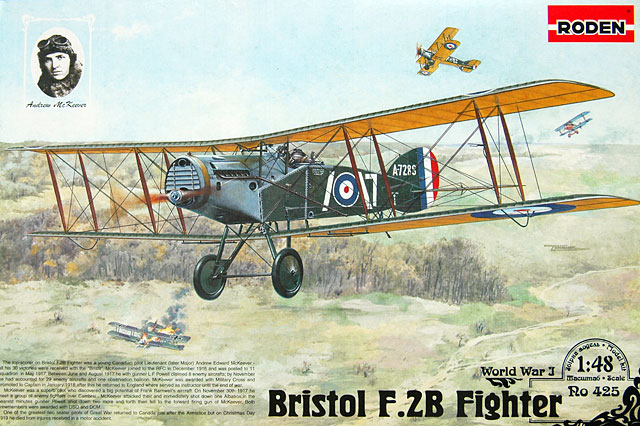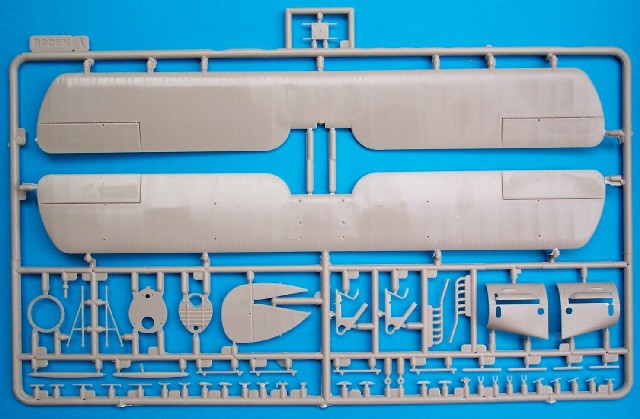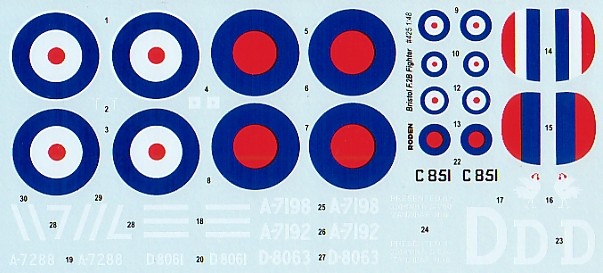|
Bristol F.2B Fighter

Roden 1/48
S
u m m a r y
|
| Catalogue Number: |
Roden Bristol F.2B Fighter kit #425 |
| Scale: |
1/48 |
| Contents and Media: |
139 parts in injection moulded
plastic; acetate sheet for windscreens; markings for three aircraft |
| Price: |
USD$17.96 from Squadron.com
|
| Review Type: |
FirstLook |
| Advantages: |
Sharp moulding, petite detail,
excellent engineering, one-piece wings and complete engine. |
| Disadvantages: |
Decals out of register, no rigging
diagram |
| Recommendation: |
Highly Recommended |
Reviewed by Robert Baumgartner

Roden's 1/48
scale Bristol F.2B Fighter may be ordered online from Squadron.com
Roden’s “scale up” policy continues with the very welcome release of the
Bristol Fighter.
Having kitted this airplane previously in 1/72nd scale it was always
going to be interesting to see which features were translated into this
larger format.
The contents consist of 3 sprues holding 139 light grey plastic parts.
Sprue U is the big surprise as this contains a complete Rolls Royce
Falcon engine, just like its baby brother!

Click the thumbnails below
to view larger images:
Naturally it comes complete with engine mounts so that the whole
front end can be displayed in all its glory. The engine panels are
separate which saves the fuselage being compromised by any cutting. A
dry fit showed that these parts fit well should one decide not to show
off the power plant.
The fuselage halves contain some good interior structure to which the
rest of the cockpit components can be added. These include the usual
seats, rudder bar, control column, instrument panel and spare Lewis
drums (16 are provided in total!). Plenty of scope is left for the
scratch builder and modellers can gain valuable insight by viewing
pictures of the RAF Museum’s remarkable restoration.
There are very slight sink marks on the outside of the fuselage due the
moulded inner detail but this is easy to rectify.
Sprue B also contains a selection of optional parts, which includes a
couple of two bladed props (left and right handed), a four bladed
example, and the ever popular spare machine guns. As usual the latter
items are beautifully portrayed. Roden didn’t forget the bombs either,
with two racks of four being supplied.
The wings are found on sprue A and here one can really appreciate the
size of this aircraft. To Rodens credit they have moulded these huge
items as one piece. As well as the very thin trailing edges, the wings
showed no distortion of any kind. Rib detail is commendably subtle and
it’s good to see a manufacturer showing restraint in this area.
The attachment of the lower wing may scare some but it needn’t. The
assembly follows Rodens 1/72nd scale release, and having had experience
with that procedure, I can assure the builder that a painkiller will not
be required.
A small acetate sheet is supplied which provides an excellent scale
representation of the windscreen.
One thing to note is that my example had a lot of mould release agent on
it so make sure your sprues get a good bath in soapy water before
committing them to paint or glue.
The instruction sheet is pretty straightforward and explains clearly
what parts are needed for each option. This has to be decided on fairly
early due to the removal of any unwanted exhaust pipe locaters.
Step 17 of my on my instruction sheet was incomplete as it showed blank
areas of where the rigging diagram was supposed to be. Unless you have
additional reference material, the box art will have to suffice.
The Albatros Publication “Bristol Fighter Vol 1” by Jack Bruce was used
when evaluating the outline of the major parts. They proved to be an
excellent match when compared to Ian Stair’s plans.
Six options are catered for on the decal sheet, which provides enough
variety to please even the fussiest of modellers. The white was out of
register of my example and it might be an idea if Roden start separating
the roundel colours into more than one decal.

The carrier film was nice and thin and testing one of the serial
numbers on a painted surface revealed no problems.
(I) Bristol F.2B D8061 of 48 Sqn. RAF, Western Front 1918
Crewed by 2/ Lt. FN Griffiths and Lt. AE Ansell. The presentation
inscription and serial number on this aircraft were merely “stick
on” pieces of fabric. This was done for photographic purposes in
appreciation of the donors.
In this machine, Ansell and Griffiths were credited with shooting
down a Pfalz D.III on the 2 July 1918. Ansell could consider himself
an “ace” as this was the 4th of 5 aircraft he downed in combination
with various pilots.
D8061 was finally shot down by Joseff Mai of Jasta 5, killing its
two occupants. In this case 2/Lts EJ McCutcheon and VS Gray.
(II) Bristol F.2B A7288 of 11 Sqn. RFC, Western Front 1917
Crewed by Lt. Andrew Edward McKeever and Lt. L F Powell.
Some sources give this aircraft as A7258. Powell was given credit
for a total of 19 aircraft, 18 of which were when flying with
McKeever. On 30th of November 1918, they were successful in claiming
4 Albatros scouts destroyed in the one day.
(III) Bristol F.2B C851 of 141 (HD) Sqn., 1918
Crewed by Lt. E E Turner and H B Barwise. They were credited with
shooting down Gotha G.V 979/16 of Bogohl 3 on the night of 19/20
May.
(IV) Bristol F.2B A7198 of 1 Sqn. Australian Flying Corps,
Palestine 1918
Crewed by Captain R Williams. The aircraft was later written off
in a crash.
(V) Bristol F.2B A7192 of 1 Sqn. Australian Flying Corps,
Palestine 1918
(VI) Bristol F.2B D8063/D of 139 Sqn. RAF, Italian Front 1918
Crewed by Maj. W G Barker and HRH Prince Edward of Wales.
With the quality of releases such as this, Roden’s Bristol F.2B deserves
to be a winner.
The finesse of the detail is outstanding and the inclusion of an entire
engine is just icing on the cake.
British two seater aircraft have not always had the attention they
deserve from manufacturers so this latest effort is especially
noteworthy. Thus all bodes well for the coming Be 2 series and maybe
even an Re 8…if we ask nicely.
Highly Recommended.
Thanks to
Squadron.com for the review
sample.
Review and Images Copyright © 2004 by
Robert Baumgartner
Page Created 18 October, 2004
Last updated 19 October, 2004
Back to HyperScale Main Page
Back to Reviews Page
|
Home | What's
New | Features
| Gallery |
Reviews | Reference
| Forum
| Search